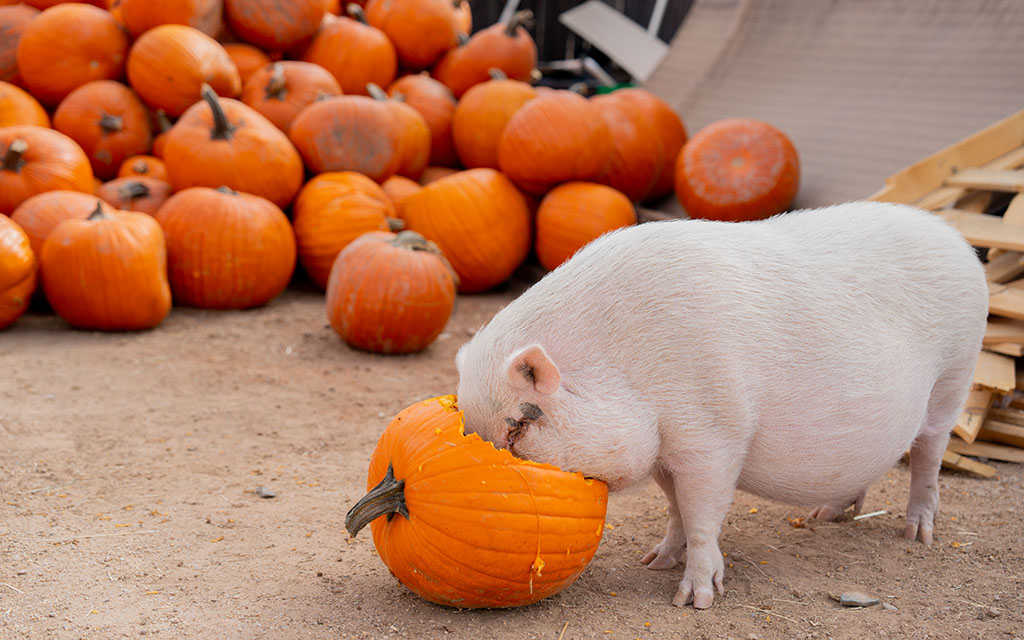
Mob the pot-bellied pig goes whole hog on a pumpkin at Better Piggies Rescue near Cave Creek on Nov. 2, 2022. (Photo by Samantha Chow/Cronkite News)
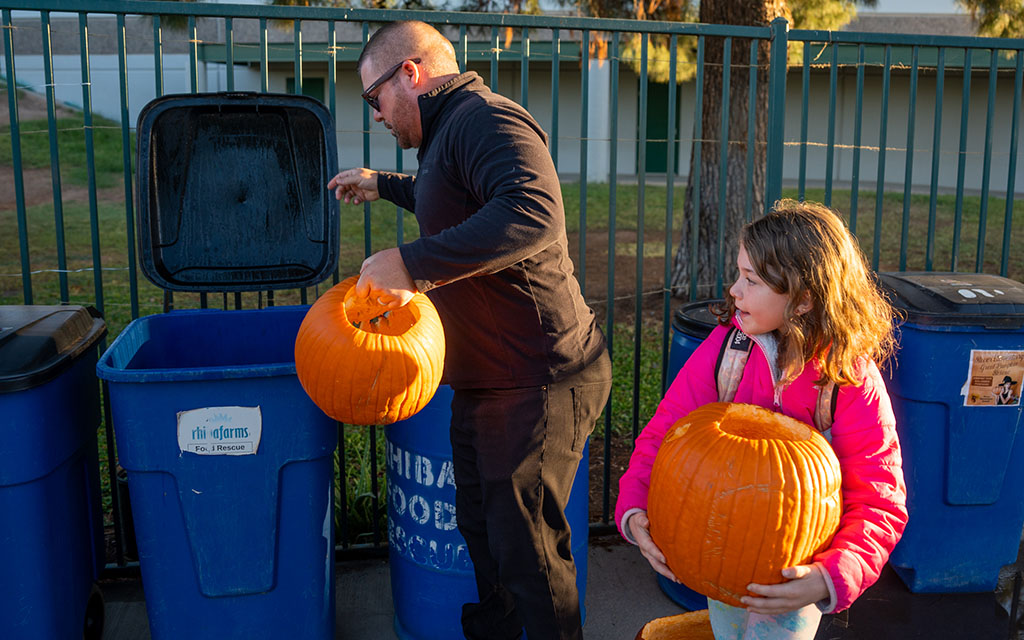
Emery Franklin, 8, right, donates carved pumpkins at Rover Elementary School in Tempe alongside her dad, Jeremy Franklin, on Nov. 2, 2022. (Photo by Samantha Chow/Cronkite News)

Princess, a pot-bellied pig, eats a pumpkin at Better Piggies Rescue near Cave Creek on Nov. 2, 2022. (Photo by Samantha Chow/Cronkite News)

Danielle Betterman, director and owner of Better Piggies Rescue, smashes a pumpkin to make it easier for her pot-bellied pigs to eat at the sanctuary near Cave Creek on Nov. 2, 2022. Betterman currently has 155 pigs at the sanctuary. (Photo by Samantha Chow/Cronkite News)
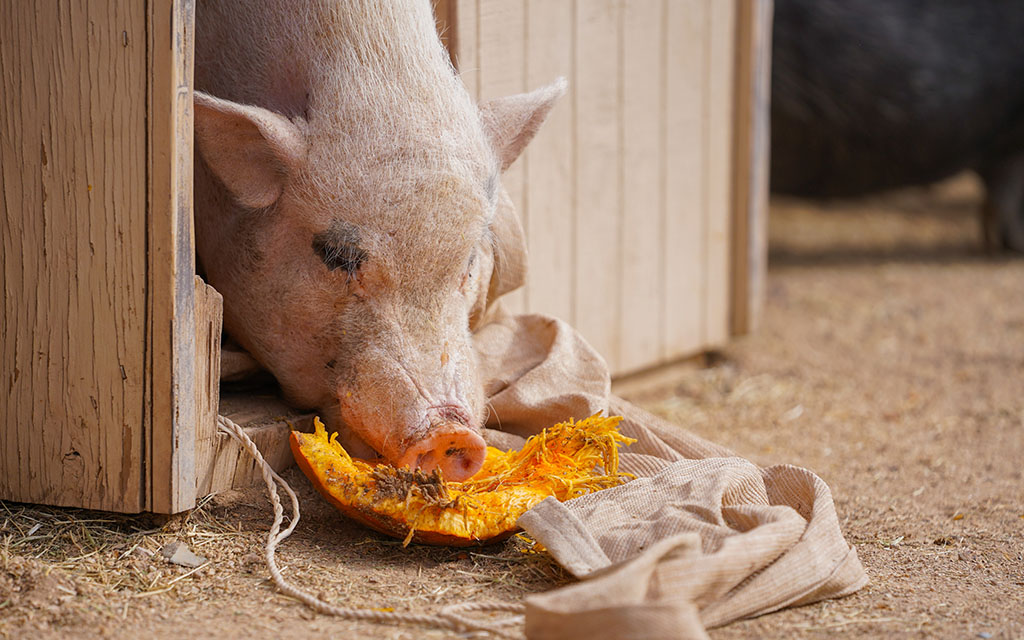
Chubs, a pot-bellied pig at Better Piggies Rescue near Cave Creek, eats a pumpkin Nov. 2, 2022. (Photo by Samantha Chow/Cronkite News)
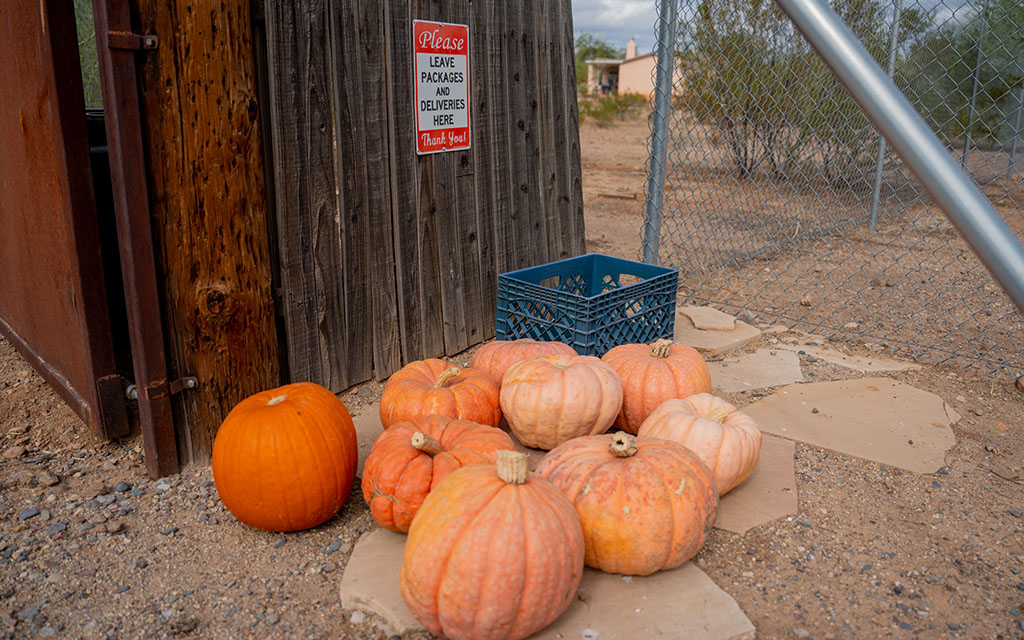
Pumpkin donations are left outside the gate at Better Piggies Rescue near Cave Creek on Nov. 2, 2022. A drop-off event will be held at the sanctuary on Nov. 5 and 6 for community members to donate their paint-free, glitter-free carved pumpkins. (Photo by Samantha Chow/Cronkite News)
TEMPE – Halloween decorations are coming down, returned to their boxes to collect dust until next year, but the shelf-life of our beloved pumpkins is fleeting.
Throwing them out isn’t the answer. When incinerated or left to rot in a landfill, pumpkins and other food waste emit carbon dioxide and methane, which are major drivers of climate change.
Luckily, groups around metro Phoenix have alternative solutions that are climate friendly.
In Tempe, Rover Elementary School is collecting pumpkins through this weekend for Rihba Farms in San Tan Valley to compost and feed to livestock.
“The pumpkins are actually highly nutritious food for the animals on the farm,” Rover Elementary Principal Dana Lineberger said, “and so it’s part of the partnership we have between farmer Mark (Rhine, from Rhiba Farm) and our school.”
The school started the Great Pumpkin Rescue last year. Rhine took videos of his sheep and chickens digging into the pumpkins, which were shared with students and the Rover community to see where their donated pumpkins went, Lineberger said.
Donating pumpkins is one way to keep them out of landfills. Composting pumpkins is another way to reduce greenhouse gas emissions, while putting nutrients back into the environment.
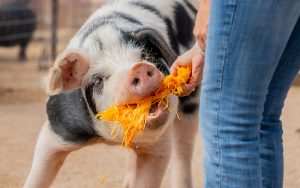
Jimmy, a farm hog, is hand fed pumpkin by Danielle Betterman at Better Piggies Rescue in Phoenix on Nov. 2, 2022. Betterman says pumpkins provide great nutritional value for pigs and help with digestion. (Photo by Samantha Chow/Cronkite News)
“Composting is really nature’s way of recycling and something that humans have been doing for 1,000s of years,” said Claudia Fabiano of the U.S. Environmental Protection Agency. “It returns valuable nutrients like carbon and nitrogen back to our soil. And so it’s really a powerful solution that we can take to ensure that food does not end up rotting in landfills and releasing methane, which will help address climate change.”
In the U.S. in 2019, 54.2 million tons of food waste was generated from a variety of sectors, including residential and farms. That’s according to ReFed, a national nonprofit organization that works to reduce food waste.
Fabiano said the Environmental Protection Agency joined the Department of Agriculture in 2015 to set a goal to reduce food waste by 50% by 2030.
“That is an extremely ambitious goal,” she said. “And because so much of food waste in the United States is actually coming from our households, each of us have a really big role to play in helping to reach that goal.”
Besides composting or donating pumpkins, Fabiano said small changes at home can have a big impact. Changing food storage techniques, like storing herbs like cilantro in a glass container with water rather than in a plastic bag, and being aware of what has already been purchased are two ways food waste can be reduced, Fabiano said.
Painted pumpkins or ones with glitter are not safe for animals or for composting, Fabiano said.
“Definitely don’t send it to the compost pile and don’t feed it to animals,” she said. “Some of the ingredients and paint or glitter can be toxic.”

Second-grade teacher Alexa Callander drops off carved pumpkins at the donation bins in front of Rover Elementary School in Tempe on Nov. 2, 2022. This is the second year the school has partnered with Rhiba Farms to reduce pumpkin waste. ((Photo by Samantha Chow/Cronkite News)
Near Cave Creek, Better Piggies Rescue collects pumpkin donations for over 150 rescue pigs.
“We’re running a couple different days, Saturday and Sunday, where people can come drop off their pumpkins from Halloween,” founder Danielle Betterman said. “They can be carved, but they can’t have mold in them, or they can be whole, either way, the pigs will love them. Pumpkins are really good for digestive tracts.”
Pumpkins can be dropped off at the front gate at Better Piggies Rescue on Saturday and Sunday, Nov. 5 and 6, and you can sign up to hang out with the pigs.
“We saw pumpkins being just thrown in the garbage. And these are great pumpkins still usable, still have a ton of good nutrition to them,” Betterman said. “There’s no reason to be throwing them in the garbage. You have a pig or an animal that enjoys eating those pumpkins, we’ll give it to them. That’s the need.”


